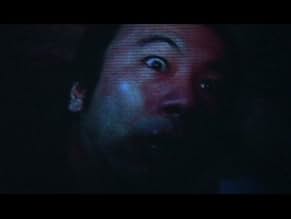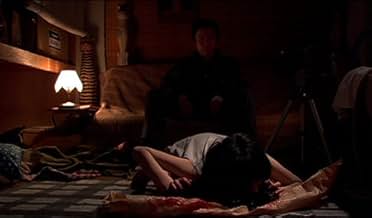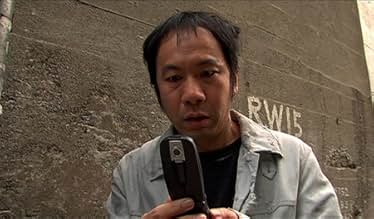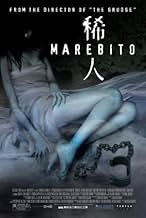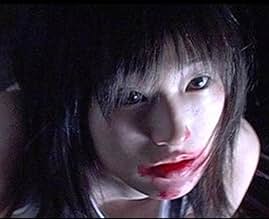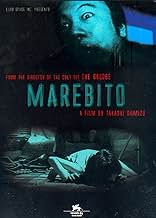IMDb रेटिंग
6.0/10
6 हज़ार
आपकी रेटिंग
अपनी भाषा में प्लॉट जोड़ेंA fear-obsessed freelance cameraman (Shinya Tsukamoto) investigates an urban legend involving mysterious spirits that haunt the subways of Tokyo.A fear-obsessed freelance cameraman (Shinya Tsukamoto) investigates an urban legend involving mysterious spirits that haunt the subways of Tokyo.A fear-obsessed freelance cameraman (Shinya Tsukamoto) investigates an urban legend involving mysterious spirits that haunt the subways of Tokyo.
- पुरस्कार
- 2 जीत और कुल 1 नामांकन
फ़ीचर्ड समीक्षाएं
Marebito starts out with an interesting premise, but somewhere along the way the movie falls apart.
A camera man captures a man in the subway committing suicide by stabbing himself in the eye. The camera man becomes transfixed by the death image of the man and studies the footage with the hopes of finding a clue as to why the man would commit such an act. He surmises that the man has experienced something so terrifying immediately before his death as to render him suicidal. So the camera man ventures into the subway for clues and finds a door that leads even further down into the subway. The beginning part of the film captured my interest.
Too bad.
What the main lead uncovers...actually what he finds beneath the subway...and what unfolds thereafter is incredibly dull. The rest of the film becomes a jumbled mess as the main character tries to rationalize, in his more and more irrational mind, the supernatural events that unfold. But the film looks rushed and uninspired...it does look like it was filmed in two weeks.
I thought Ju-on was creepy and fairly good as a horror film. The director's effort on this film is unfocused and meandering; he even interlaces at points in the film, clumsily I might add, with discussions of philosophy and the supernatural in the hopes, I suppose, of lending the film some gravitas. Is the director trying to be metaphorical and deliberately obtuse? I don't know and I did not care.
Because I found some parts of the film creepy and even innovative, I rate this film: Average.
A camera man captures a man in the subway committing suicide by stabbing himself in the eye. The camera man becomes transfixed by the death image of the man and studies the footage with the hopes of finding a clue as to why the man would commit such an act. He surmises that the man has experienced something so terrifying immediately before his death as to render him suicidal. So the camera man ventures into the subway for clues and finds a door that leads even further down into the subway. The beginning part of the film captured my interest.
Too bad.
What the main lead uncovers...actually what he finds beneath the subway...and what unfolds thereafter is incredibly dull. The rest of the film becomes a jumbled mess as the main character tries to rationalize, in his more and more irrational mind, the supernatural events that unfold. But the film looks rushed and uninspired...it does look like it was filmed in two weeks.
I thought Ju-on was creepy and fairly good as a horror film. The director's effort on this film is unfocused and meandering; he even interlaces at points in the film, clumsily I might add, with discussions of philosophy and the supernatural in the hopes, I suppose, of lending the film some gravitas. Is the director trying to be metaphorical and deliberately obtuse? I don't know and I did not care.
Because I found some parts of the film creepy and even innovative, I rate this film: Average.
Not too much to say about this one. The story starts off relatively interesting but pretty much dies on the vine. The "twist" ending doesn't really do much to save it either.
A guy is obsessed with "terror" and is searching for the "ultimate fear". He goes around looking for it and comes across a strange blood-drinking chick instead. They hang around a bunch and then the "revalation" as to who this chick is and what this guy's life is all about is made known...
The beginning of the film started off with some decent concepts including some Lovecraft-ian references that were never expanded on, and eventually just ends up being a bore. Nothing really notable at all in this one. Not horrible and will probably be loved by J-horror bandwagon-jumpers, but I've seen too much of this stuff (ranging from "classic" to flat-out horrible...) to be thrilled with every new one that comes down the pike. Not the worst of the bunch but very, very average..5/10
A guy is obsessed with "terror" and is searching for the "ultimate fear". He goes around looking for it and comes across a strange blood-drinking chick instead. They hang around a bunch and then the "revalation" as to who this chick is and what this guy's life is all about is made known...
The beginning of the film started off with some decent concepts including some Lovecraft-ian references that were never expanded on, and eventually just ends up being a bore. Nothing really notable at all in this one. Not horrible and will probably be loved by J-horror bandwagon-jumpers, but I've seen too much of this stuff (ranging from "classic" to flat-out horrible...) to be thrilled with every new one that comes down the pike. Not the worst of the bunch but very, very average..5/10
I highly suggest seeing this film if you are a fan of Shimizu's works. Apparently it was filmed before Ju-On, in only eight days. This shows what a master filmmaker can do in such a short time. This movie will make you feel very uncomfortable and extremely disturbed. It is about a camera man who wants nothing more than to feel the most extreme fear. He than finds a subterranean lair filled with eerie creatures called Deros, and he finds a girl (or a creature much like a girl) chained to a rock and takes her home to care for her. He attempts to feed her but he finds that the only thing that she'll eat is blood. The only problems I had with it were the shaky camera moves (Blair-Witch style)but since he only made it in eight days...he has an excuse, and it will go to a normal camera to give your eyes a break. Overall a masterpiece in psycho-horror.
A strange film by Grudge writer/director Takashi Shimizu.
Shinya Tsukamoto (Ichi the Killer) is consumed with finding out the source of terror that caused a man to stab himself in the eye. He wants to experience the same terror - terror so horrible that it would cause you to want to kill yourself.
He goes underground looking for the beings that inhabit the tunnels under Tokyo and finds a naked girl, who he brings home to live with him. The girls is more animal than human and he kills to provide her blood rather than give her his own blood, which she wants.
It is not certain throughout whether he is going mad or finding what he is searching for. He even tries to escape, but resumes the search until he finally succumbs to the terror.
Despite the shaky camera work, which some like, but which distracts me, it was a fascinating look at terror and certainly a film that contains much more than available at first glance. A blend of mysticism and horror, it is a worthy view for fans of Japanese horror.
Shinya Tsukamoto (Ichi the Killer) is consumed with finding out the source of terror that caused a man to stab himself in the eye. He wants to experience the same terror - terror so horrible that it would cause you to want to kill yourself.
He goes underground looking for the beings that inhabit the tunnels under Tokyo and finds a naked girl, who he brings home to live with him. The girls is more animal than human and he kills to provide her blood rather than give her his own blood, which she wants.
It is not certain throughout whether he is going mad or finding what he is searching for. He even tries to escape, but resumes the search until he finally succumbs to the terror.
Despite the shaky camera work, which some like, but which distracts me, it was a fascinating look at terror and certainly a film that contains much more than available at first glance. A blend of mysticism and horror, it is a worthy view for fans of Japanese horror.
Thanks to his series of ghost stories, "Ju-on", Japanese director Takashi Shimizu has become one of the most recognized names of the New Wave of Asian horror cinema, the movement of young Asian directors that since the late 90s has produced some of the best and most original horror movies of the last years. The enormous success of his "Ju-on" series took Shimizu to the U.S., in order to direct a remake of the third installment of the series ("Ju-on: The Grudge"), named simply as "The Grudge"; but right before working on the remake, Shimizu took some days with fellow director Shinya Tsukamoto and a small crew to make a very low-budget horror movie, pretty much on the style he used to make when "Ju-on" was a straight to video release, but this time with a very different kind of story.
Masuoka (Shinya Tsukamoto) is a freelance cameraman almost completely detached from the world and entirely focused on his preference for videotaping and doing camera-work. Onde day, he accidentally tapes the suicide of a man named Arei Furoki (Kazuhiro Nakahara) on a subway station. The strange characteristics of this event, makes Masuoka to be obsessed with the idea of a fear so powerful that only death can erase, so in an attempt to understand Furoki's fear he descends into the underground tunnels of Tokio, discovering the entrance to a bizarre cavern that seems like a passage to the underworld. Is in this caverns where he finds a naked girl (Tomoi Miyashita) chained to the wall. He unchains her and takes her to his apartment, but soon he discovers that this girl (whom he names "F") is not a normal person, and that her presence in his world will make a darker side of him to come out.
"Marebito" was written by Chiaki Konaka (better known as the writer of the famous anime, "Serial Experiments Lain"), and like most of his works, it is a dark psychological story with a slight cometary on the relationship between humans and the technology they produce. Narrated by Masuoka, the story is told from his perspective, so we are taken along him through his discovery of mysteries that should be better kept secret and the terrific consequences of his actions. It is very Lovecraftian in the sense that, like in the stories by H.P. Lovecraft, we have a main character who may not be entirely sane, and whom his curiosity takes him to the darker sides of human nature. His relationship with the strange girl "F", and his attempts to establish communication with her become the focal point of the plot of "Marebito", although like in other works by Konaka, reality is not always what it seems.
It seems that this "return to roots" was really beneficial for Takashi Shimizu, as the work he offers in "Marebito" is once again a very fresh and original horror movie that proves that there is more in this young director than the "Ju-on" series. By working again on a shoestring budget, Shimizu is able to capture the simple and monotone life of Masuoka, and with the use of digital video he mimics the world as his main character sees it: a world through the camera lens. While the movie moves at a very slow pace, it really is an improvement over the style of using disjointed story lines in "Ju-on", and never falls into the trap of being boring or repetitive (a common flaw of the "Ju-on" movies). However, a trait kept from "Ju-on", is Shimizu's skill to create ominous haunting atmospheres with common everyday objects, this time, the video screens and what's on them is the focus of the film.
Shinya Tsukamoto is better known as the director of the remarkable and influential films like "Tetsuo" (1989) and "Tokyo Fist" (1995), but here he offers his talents as an actor in a film where he plays the main character. While a very talented director, Tsukamoto is not really a great actor, and both he and Shimizu seem to be aware of that, so his portrait of Masuoka is conceived as a typical man with obsessive behavior, entering the unknown. The movie's highlight is Tomomi Miyashita, who gives life to the feral child "F", with a frighteningly believable performance that definitely gives the chills. Kazuhiro Nakahara, Miho Ninagawa and Shun Sugata appear in supporting roles, but their appearances are limited, as the movie focuses entirely on Masuoka and the consequences of his relationship with "F".
"Marebito" is an excellent example of how imagination and a good plot can make a film work even with the most limited resources. Of course, the movie suffers the most in the special effects department, with some of the visuals looking painfully amateurish (although probably that was the intention). The use of digital camera may be annoying to those expecting a good looking film, but instead of being a flaw, its use in the film gives the story a realistic tone, as if we were really watching a person's descent into madness. Some people have criticized the convoluted plot of Konaka's story, filled with many details and references that often make no sense or have twisted meanings in the movie; however, I find the storyline captivating because of that unpredictability, and the fact that Shimizu moves away from the ghost stories that have become typical of Asian horror is really refreshing.
With his "Ju-on" ghost stories, Takashi Shimizu became known worldwide as a major horror director, but personally I think that "Marebito" is the movie that truly reveals him as a horror author. It's not a movie destined to be a hit, but it's one that shows a different take on horror and while maybe "The Grudge" is the movie that most people relate to Shimizu, but personally, I think that "Marebito" is a much better and more satisfying movie. 8/10
Masuoka (Shinya Tsukamoto) is a freelance cameraman almost completely detached from the world and entirely focused on his preference for videotaping and doing camera-work. Onde day, he accidentally tapes the suicide of a man named Arei Furoki (Kazuhiro Nakahara) on a subway station. The strange characteristics of this event, makes Masuoka to be obsessed with the idea of a fear so powerful that only death can erase, so in an attempt to understand Furoki's fear he descends into the underground tunnels of Tokio, discovering the entrance to a bizarre cavern that seems like a passage to the underworld. Is in this caverns where he finds a naked girl (Tomoi Miyashita) chained to the wall. He unchains her and takes her to his apartment, but soon he discovers that this girl (whom he names "F") is not a normal person, and that her presence in his world will make a darker side of him to come out.
"Marebito" was written by Chiaki Konaka (better known as the writer of the famous anime, "Serial Experiments Lain"), and like most of his works, it is a dark psychological story with a slight cometary on the relationship between humans and the technology they produce. Narrated by Masuoka, the story is told from his perspective, so we are taken along him through his discovery of mysteries that should be better kept secret and the terrific consequences of his actions. It is very Lovecraftian in the sense that, like in the stories by H.P. Lovecraft, we have a main character who may not be entirely sane, and whom his curiosity takes him to the darker sides of human nature. His relationship with the strange girl "F", and his attempts to establish communication with her become the focal point of the plot of "Marebito", although like in other works by Konaka, reality is not always what it seems.
It seems that this "return to roots" was really beneficial for Takashi Shimizu, as the work he offers in "Marebito" is once again a very fresh and original horror movie that proves that there is more in this young director than the "Ju-on" series. By working again on a shoestring budget, Shimizu is able to capture the simple and monotone life of Masuoka, and with the use of digital video he mimics the world as his main character sees it: a world through the camera lens. While the movie moves at a very slow pace, it really is an improvement over the style of using disjointed story lines in "Ju-on", and never falls into the trap of being boring or repetitive (a common flaw of the "Ju-on" movies). However, a trait kept from "Ju-on", is Shimizu's skill to create ominous haunting atmospheres with common everyday objects, this time, the video screens and what's on them is the focus of the film.
Shinya Tsukamoto is better known as the director of the remarkable and influential films like "Tetsuo" (1989) and "Tokyo Fist" (1995), but here he offers his talents as an actor in a film where he plays the main character. While a very talented director, Tsukamoto is not really a great actor, and both he and Shimizu seem to be aware of that, so his portrait of Masuoka is conceived as a typical man with obsessive behavior, entering the unknown. The movie's highlight is Tomomi Miyashita, who gives life to the feral child "F", with a frighteningly believable performance that definitely gives the chills. Kazuhiro Nakahara, Miho Ninagawa and Shun Sugata appear in supporting roles, but their appearances are limited, as the movie focuses entirely on Masuoka and the consequences of his relationship with "F".
"Marebito" is an excellent example of how imagination and a good plot can make a film work even with the most limited resources. Of course, the movie suffers the most in the special effects department, with some of the visuals looking painfully amateurish (although probably that was the intention). The use of digital camera may be annoying to those expecting a good looking film, but instead of being a flaw, its use in the film gives the story a realistic tone, as if we were really watching a person's descent into madness. Some people have criticized the convoluted plot of Konaka's story, filled with many details and references that often make no sense or have twisted meanings in the movie; however, I find the storyline captivating because of that unpredictability, and the fact that Shimizu moves away from the ghost stories that have become typical of Asian horror is really refreshing.
With his "Ju-on" ghost stories, Takashi Shimizu became known worldwide as a major horror director, but personally I think that "Marebito" is the movie that truly reveals him as a horror author. It's not a movie destined to be a hit, but it's one that shows a different take on horror and while maybe "The Grudge" is the movie that most people relate to Shimizu, but personally, I think that "Marebito" is a much better and more satisfying movie. 8/10
क्या आपको पता है
- ट्रिवियाTakashi Shimizu shot the film in just eight days, between the production dates for Ju-on (2002) and its remake, डरते रहो (2004).
टॉप पसंद
रेटिंग देने के लिए साइन-इन करें और वैयक्तिकृत सुझावों के लिए वॉचलिस्ट करें
- How long is Marebito?Alexa द्वारा संचालित
विवरण
बॉक्स ऑफ़िस
- बजट
- JP¥50,00,000(अनुमानित)
- US और कनाडा में सकल
- $13,983
- US और कनाडा में पहले सप्ताह में कुल कमाई
- $3,852
- 11 दिस॰ 2005
- दुनिया भर में सकल
- $1,07,259
- चलने की अवधि
- 1 घं 32 मि(92 min)
- रंग
- पक्ष अनुपात
- 1.85 : 1
इस पेज में योगदान दें
किसी बदलाव का सुझाव दें या अनुपलब्ध कॉन्टेंट जोड़ें


